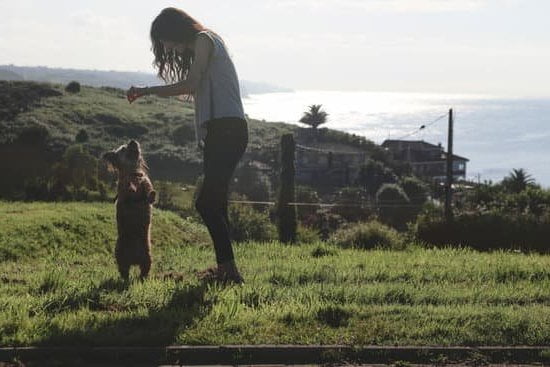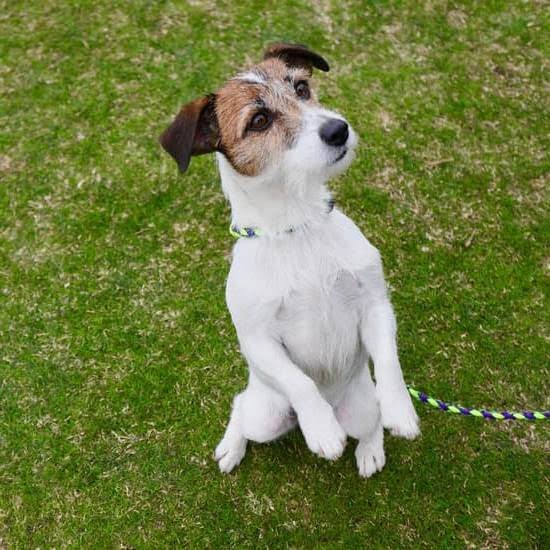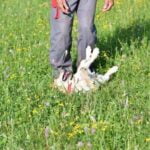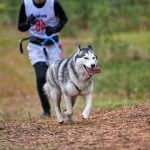Are you tired of your dog constantly jumping on people and furniture? In this article, we will explore effective methods on how to train your dog not to jump. Understanding why dogs exhibit this behavior is the first step in addressing it. We will discuss the negative consequences of jumping, positive reinforcement training methods, teaching alternative behaviors, and the importance of consistency in training.
One of the key reasons why dogs jump is to seek attention or simply to greet their owners and visitors. Dogs are social animals and jumping can be a way for them to express excitement and eagerness. However, this behavior can become problematic, leading to negative consequences such as scratched skin, torn clothing, and even fear in some individuals who are uncomfortable around dogs.
Positive reinforcement training is a highly effective method for teaching your dog not to jump. By rewarding desired behaviors with treats, praise or other rewards, you can encourage your dog to greet people calmly without jumping. Additionally, teaching alternative behaviors such as sitting or offering a toy instead of jumping can redirect their energy in a more appropriate manner. Consistency is also crucial in reinforcing these new behaviors and setting boundaries for your dog’s greetings.
Negative Consequences of Jumping Behavior
When your dog jumps up on people, it may seem harmless and even endearing at first. However, there are negative consequences to this behavior that can impact both your dog and the people around them.
Risk of Injury
One of the biggest negative consequences of jumping behavior is the risk of injury. A large or overly excited dog can inadvertently knock over a child, elderly person, or someone with mobility issues, causing them to fall and potentially get hurt. Additionally, a dog who jumps up on strangers could provoke fear or anxiety in those who are uncomfortable around dogs, leading to potential conflicts or even legal issues.
Reinforcement of Dominance
Allowing your dog to jump on you or others can also reinforce dominant behaviors that may lead to other unwanted actions like aggression or lack of respect for boundaries. If a dog learns that they can jump on people whenever they want attention, they may start exhibiting other undesirable behaviors as well.
Damage to Clothing and Property
Another consequence of jumping behavior is potential damage to clothing or property. Sharp claws from an enthusiastic jumper can tear clothing, scratch skin, or leave marks on furniture and walls. This not only leads to inconvenience and additional costs for their owners but also creates a negative perception of the dog’s manners.
Understanding these negative consequences emphasizes the importance of training your dog not to jump. By addressing the root cause of this behavior and using positive reinforcement techniques, you can help your dog learn alternative behaviors that are more appropriate and acceptable for interacting with humans.
Positive Reinforcement Training Methods
Positive reinforcement training is a highly effective method for teaching your dog not to jump. This training technique focuses on rewarding desired behaviors, rather than punishing unwanted ones. By using positive reinforcement, you can effectively communicate to your dog that they will receive a reward for staying calm and not jumping.
Here are some positive reinforcement techniques you can use to train your dog not to jump:
- Treat-based training: Whenever your dog behaves calmly and does not jump, immediately give them a treat. This will reinforce the idea that not jumping leads to positive rewards.
- Clicker training: Using a clicker to mark the moment when your dog doesn’t jump, followed by a treat, can help them make the connection between the behavior and the reward.
- Verbal praise: In addition to treats or clicker sounds, verbal praise such as “good boy” or “good girl” can also be used as positive reinforcement when your dog refrains from jumping.
It’s important to note that consistency is key when using positive reinforcement. Every time your dog refrains from jumping, they should be rewarded. By consistently reinforcing the desired behavior, your dog will learn that not jumping leads to good things.
By utilizing positive reinforcement training methods, you can effectively teach your dog not to jump in a way that is both gentle and effective.
Remember: The key principles of positive reinforcement are rewards, consistency, and patience when teaching dogs new behaviors like how to train your dog not to jump.
Teaching Alternative Behaviors
When it comes to training your dog not to jump, one of the most effective approaches is to teach alternative behaviors. Rather than simply telling your dog “no” when they jump, it’s important to provide them with clear guidance on what you’d like them to do instead. Here are some alternative behaviors you can teach your dog to replace jumping:
1. Sitting on command: Teach your dog to sit on command whenever they greet someone or are feeling excited. This can help redirect their energy and prevent them from jumping.
2. Offering a paw: Some dogs naturally want to use their paws when greeting people, so teaching them to offer a paw as an alternative greeting behavior can be a great substitute for jumping.
3. Holding a toy: Encouraging your dog to hold a toy in their mouth when they greet someone can also redirect their energy and serve as an alternative behavior to jumping.
By consistently practicing these alternative behaviors and rewarding your dog for performing them instead of jumping, you will effectively communicate the behavior you prefer and reduce the likelihood of jumping.
Remember that teaching alternative behaviors takes time and patience, so be sure to remain consistent with your training efforts and always use positive reinforcement techniques.
Overall, understanding how to train your dog not to jump involves being proactive in providing them with clear alternatives and reinforcing these behaviors through consistent training. By doing so, you’ll help establish new habits for your furry friend while reducing unwanted jumping behavior.
Consistency in Training and Setting Boundaries
One of the most important aspects of training your dog not to jump is consistency. Dogs thrive on routine, so it’s crucial to be consistent in your training methods and expectations. This means everyone in the household should use the same commands and techniques when working with the dog. If one family member allows jumping while another does not, it will only confuse the dog and make training less effective.
In addition to consistency, setting boundaries is essential when teaching your dog not to jump. Boundaries can be physical, such as using a baby gate or crate when guests come over, or they can be verbal cues that indicate an unacceptable behavior. It’s important to communicate these boundaries clearly and consistently so that your dog understands what is expected of them.
Moreover, setting realistic expectations for your dog’s behavior is also necessary. Remember that dogs aren’t born knowing our rules, so it’s essential to be patient as they learn. Consistency and clear boundaries will help reinforce positive behaviors and discourage jumping.
| Training Methods | Benefits |
|---|---|
| Use of consistent commands and techniques | Easier for the dog to understand what is expected |
| Setting physical and verbal boundaries | Helps reinforce what behavior is acceptable |
| Patiently setting realistic expectations | Aids in effectively training the dog not to jump |
Managing Dog’s Excitement and Energy Levels
Understanding why dogs jump, as discussed in the previous section, is crucial in addressing this behavior. One aspect of managing a dog’s jumping behavior involves managing their excitement and energy levels. Dogs often jump out of excitement when they greet their owners or visitors, especially if they have pent-up energy from not getting enough exercise.
One effective way to manage a dog’s excitement and energy levels is through regular exercise. Taking your dog for daily walks, engaging them in playtime, or incorporating interactive toys can help burn off excess energy and reduce the likelihood of jumping behavior. Providing mental stimulation through training sessions or puzzle toys can also help keep your dog mentally and physically engaged.
In addition to regular exercise, it’s essential to create a calm environment at home to prevent overexcitement. Avoid encouraging high-energy behaviors by staying calm during greetings and avoiding rough play that can escalate your dog’s arousal levels.
By providing an outlet for your dog’s physical and mental needs while maintaining a calm atmosphere at home, you can effectively manage their excitement and energy levels, ultimately reducing their tendency to jump on people. These strategies contribute to how to train your dog not to jump by addressing the root causes of the behavior and providing healthy alternatives for expressing their natural enthusiasm.
Seeking Professional Help if Necessary
When to Seek Professional Help
If you have been consistent in your training methods and your dog still continues to jump excessively, it might be time to consider seeking professional help. A certified dog trainer or animal behaviorist can provide valuable insight into your dog’s behavior and offer personalized training techniques tailored to your specific situation.
The Benefits of Professional Training
Professional trainers have the knowledge and experience to address underlying issues that may be causing your dog’s jumping behavior. They can also help you identify any mistakes you may be making in your training approach. Additionally, a professional can work with both you and your dog to ensure that the training is effective and sustainable in the long run.
Working With a Trainer or Behaviorist
During professional training sessions, the focus will be on identifying the root cause of your dog’s jumping behavior and implementing specialized techniques to address it. A trainer or behaviorist will also educate you on how to effectively communicate with your dog and establish healthy boundaries. Through consistent guidance and support, you can learn how to train your dog not to jump in a way that strengthens the bond between you and your furry companion.
Seeking professional help for canine behavioral issues is not a sign of failure, but rather a proactive step towards creating a harmonious relationship with your pet. With the right expertise and guidance, you can effectively address your dog’s jumping behavior and cultivate positive habits for a lifetime of mutual respect and understanding.
Common Mistakes to Avoid When Training Your Dog Not to Jump
In conclusion, training your dog not to jump is an essential part of responsible pet ownership and can greatly improve the relationship between you and your furry friend. Understanding why dogs jump is the first step in addressing this behavior. It’s crucial to recognize that jumping is often a result of excitement, frustration, or a desire for attention. By understanding the root cause, pet owners can better address the behavior with positive reinforcement training methods.
Negative consequences of jumping behavior can include potential harm to others, especially children and elderly individuals. It can also lead to damage of clothing and scratches or injuries. Therefore, it’s important to teach alternative behaviors and consistently reinforce those behaviors through positive reinforcement techniques.
Consistency in training and setting boundaries are vital elements in effectively training your dog not to jump. This means enforcing the same rules for jumping with all members of the household as well as visitors.
Additionally, managing your dog’s excitement and energy levels through regular exercise and playtime can help minimize jumping behavior. Lastly, if despite consistent efforts your dog continues to exhibit jumping behavior, seeking professional help from a qualified dog trainer or behaviorist can provide valuable guidance on how to train your dog not to jump effectively.
By avoiding common mistakes such as using punishment-based methods or inadvertently reinforcing the jumping behavior, pet owners can successfully train their dogs not to jump and foster a harmonious relationship built on respect and understanding.
Frequently Asked Questions
How Do I Get My Dog to Stop Jumping?
Training your dog to stop jumping requires consistency, positive reinforcement, and patience. Start by teaching them the “sit” command and rewarding them when they obey. Use the “off” command when they jump, and redirect their energy into more appropriate behaviors.
What Is the Command to Stop a Dog From Jumping?
The command to stop a dog from jumping is “off.” This command teaches your dog to stop jumping and to keep all four paws on the ground. Consistently using this command and rewarding good behavior will help reinforce the message.
Will My Dog Grow Out of Jumping Up?
Some dogs may grow out of jumping up as they mature and calm down with age. However, it’s important to address this behavior early on with training and consistent reinforcement to prevent it from becoming a long-term habit.

Welcome to the blog! I am a professional dog trainer and have been working with dogs for many years. In this blog, I will be discussing various topics related to dog training, including tips, tricks, and advice. I hope you find this information helpful and informative. Thanks for reading!





